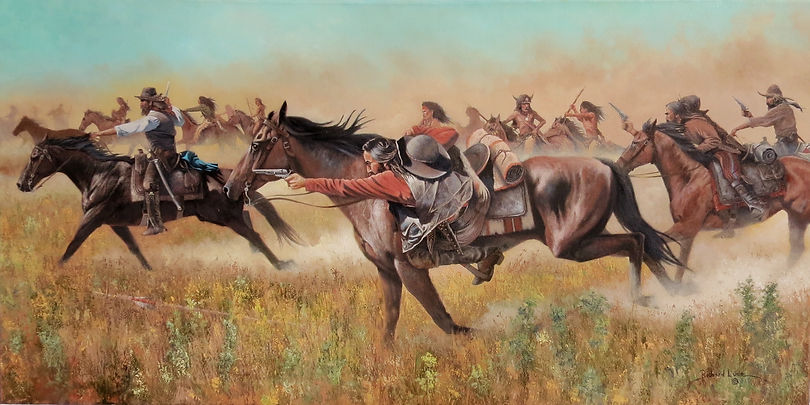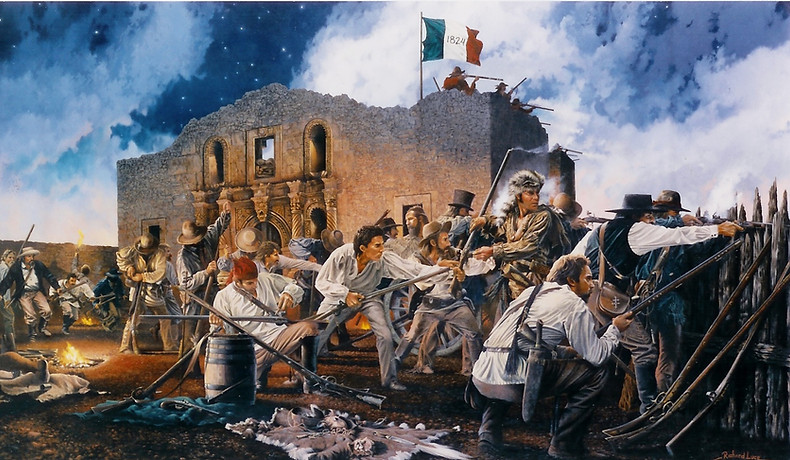"Kings Mountain was the first link in a chain of evils that followed each other in regular succession until they at last ended in the total loss of America."
Sir Henry Clinton, Commander of British forces in America

Sample
"The Muster at Abingdon"
24x48 Oil in the collection of the city of Abingdon, VA.
On September 24th Col. William Campbell addressed his militia before leaving their muster grounds for the rendezvous at the Sycamore Shoals on the Watauga River. There they would join up with the militias of Col. Isaac Shelby, Col. John Sevier and Col. Charles McDowell.

Sample
"The Backwater Men"
24x30 oil in private collection
The Backwater Men was a derogatory name given to the pioneers who settled over the Blue Ridge Mountains. Other names given to them by the British included overmountain men, backwoods mongrels and damned banditti. However these men proved to be a formidable force by totally defeating Maj. Patrick Ferguson's larger Tory army at Kings Mountain.

Sample
"John Sevier and the Wataugans"
18x24 oil in private collection
John Sevier arriving with his 240 man militia at the Sycamore Shoals on September 25th, 1780.

Sample
"Nolichucky Jack"
20x24 oil in private collection
John Sevier was a well known and much respected frontier leader who gained the respect and loyalty of all who knew him. One of the driving forces in the patriot victory at Kings Mountain, he later fought in other numerous battles always resulting in victory. He later became the first Governor of the State of Tennessee.

Sample
"A Call to Arms"
24x48 oil in private collection
On September 25th, 1780 militia groups from the backwoods areas of Virginia and what would later become east Tennessee answered a call to arms and gathered at the Sycamore Shoals on the Watauga River. Col. William Campbell's 200 men crossed the river in the early afternoon and were followed later that day by an additional 200 men led there by his cousin Col. Arthur Campbell.There was much rejoicing at the arrival of this unexpected second group for now their numbers swelled to over 1000 men. Thus began the march to find and defeat Maj. Patrick Ferguson and his Tory force.
Giclee canvas prints available in store

Sample
"The Rendezvous at Quaker Meadows"
36x48 oil sold
On September 30th the Overmountain Men rendezvoused with 360 militia from the Yadkin River Valley led there by Col. Benjamin Cleveland and Maj. Joseph Winston. They meet in the late afternoon under a very old and large tree called the Council Oak. There, the wet and tired men were able to rest, eat and dry out their clothes by fires made from the McDowell's fence rails which they graciously offered up.
Left to right: Col. John Sevier, Col. Isaac Shelby, Col. William Campbell, Maj. Joseph McDowell, Col. Benjamin Cleveland, Col. Charles McDowell and Maj. Joseph Winston.

Sample
"The Patriot Victory at Kings Mountain"
36x72 oil in the collection of Kings Mountain National Battlefield Park, SC.
After two weeks of crossing mountains, fording rivers,traveling through rain and snow and days without food the Overmountain Men finally caught up with Maj. Ferguson's Tory army.
Following a forced night march through heavy rain, the sky began to clear the following day when they approached their goal. At 3 pm on October 7th with 910 of their ablest mounted fighters they surrounded Kings Mountain and began their assault against Ferguson's Tory force of 1100 men.
The patriot commander, Col. William Campbell gave the order to "scream like hell and fight like devils" as they gave the Tories "Indian play"; the best way they had learned to fight after years of defending their frontier homes.
The Tories fought hard but they were outclassed and began to fall back to their wagon circle as the patriots crested the hill on all sides. Ferguson seeing the hopelessness of his position and unwilling to surrender to this Damned Banditti tried to break free and was shot off his horse. The Tories surrendered soon after.
The 1 hour and 5 minute battle halted the British Southern Strategy to end the rebellion and led the way to the final American victory at Yorktown the following year.
Giclee canvas prints available in store

Sample
Battle Map of Kings Mountain Campaign
36x24 signed canvas giclee print $250
"The Battle of Walker's Creek"

Sample
24x48 oil sold at Texas Treasures Gallery, Boerne, Texas
On June 8th 1844 about 80 Comanches ambushed 15 Texas Rangers near the Pedernales River north of San Antonio. The Indians thinking they would have an easy victory were very surprised when the Rangers kept firing their pistols without having to stop and reload. Capt. Jack Hayes had just outfitted his men with the new Colt 5 shot Patterson revolver. This new big medicine caused the Indians to panic and a 3 mile running battle ensued. After suffering 30 killed the Comanche war party leader later stated that he would never fight Jack Hayes again.
"For God and Texas"

Sample
36x60 oil in private collection
At 5 am on March 6,1836 the 13 day siege of the Alamo came to a violent end. With trumpets blaring the "Deguello", the Mexican warning of no quarter, the huge army under General Santa Anna attacked. The 189 defenders put up a heroic defense but being severely outnumbered were overwhelmed and wiped out to a man. One of the more famous defenders was David Crockett who had just arrived in Texas from Tennessee as a volunteer. He served as only a high private not as a colonel as he was better known. He fought under captain Harrison's company known as the Tennessee Mounted Volunteers and defended the south stockade wall against mass attacks. When the north wall was breached the Mexicans swarmed into the compound and hand to hand combat ensued.
The painting depicts David Crockett at the south wall with the other Tennessee volunteers at the beginning of the battle.
24x40 Signed and numbered edition of 189 canvas giclee print available $800
Paper print 19x32 image size signed and numbered edition of 925 available $140
"Custer's Last Command"
Sample
40x60 oil in private collection

Sample
40 x 60 oil in private collection
_JPG.jpg)
Key to identify figures
Giclée prints are available in two sizes:
24 x 36 canvas signed and numbered
edition of 263 $725
16 x 24 canvas or paper print signed
open edition $280
In the painting I show the point in the battle when the Indians have most likely destroyed Lieut. Calhoun's and Capt. Keogh's positions and are surrounding Custer and his headquarters group. His brother Tom and remnants of Company C along with Company F under Capt. Yates are also shown.
Also included are Lieuts. William Cooke and Algernon Smith along with Sgt. Major Sharrow. Custer's youngest brother Boston Custer, and nephew Autie Reed are shown but were later found at the bottom of the hill in a futile attempt at escape.
Most of the soldiers shown are from F Company who wore black hats and rode bay horses. However recent findings suggest that most if not all of their horses were run off by the Indians.
Company C wore gray hats and rode light sorrel horses and Company E wore gray hats and rode gray horses. I have included these as well as "Vic" Custer's sorrel horse. Most of the dead horses found on the hill were from C and E troops.
Many of the officers and soldiers wore frontier style clothing while in the field and some wore shirts similar to those of the Custer clan. It was a blue wool bib front shirt with piping.
Some officers had a personal preference in weapons. Lieut. Cooke preferred a .45/70 infantry rifle instead of a carbine. Capt. Yates preferred a .44 cal. Smith and Wesson over the standard issue Colt. George and Tom Custer used Webley Bulldog revolvers.
In the painting I have Boston Custer firing a Sharps hunting rifle belonging to his brother. Autie Reed has picked up a carbine but being so young and inexperienced is not firing.
The army issued bullets were copper cased and caused a problem by sometimes splitting and getting stuck in the breech. They then had to be dug out with a knife as one soldier is doing.
The gun smoke and dust were very thick making it difficult to see and breath. The Indians fired bullets and arrows into the dust cloud from every direction until the final rush at the end.
"Crockett and McGregor"

Sample
24x36 oil depicting Crockett and McGregor playing during the Alamo Siege
Original Oil available contact Richard
"Officer's Call"

Sample
Lt. Colonel George Custer ordering an officers call
20x24 original oil in private collection
"Campaigning With Custer"
.jpg)
Sample
20 x 30 oil at West Lives On Gallery, Jackson, WY.
canvas giclée prints available in shop
"The Founding of Harmony Landing"

Sample
In the 1790's a group of men decided to explore the Ohio River region for a place to build a settlement. The leader of the group was a former British officer named Captain William Snowden who fell in love with the Ohio country while serving during the Revolutionary war. Their plan was to explore the Ohio river in a large fortified flatboat for a landing site they would all agree on. When they came to a wide bend in the river they decided this was the place. They named the site Harmony Landing and proceeded to build their town. Captain Snowden's brick house still stands today as part of the Harmony Landing Country Club.
Original 36x64 oil is in the collection of the Oldham County Fiscal Court Building in LaGrange, KY.
"God Bless America"

Sample
Painting in honor of those who lost their lives on September 11, 2001.
48x36 original oil in private collection
